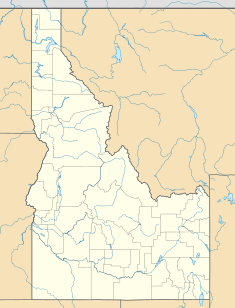Barber Dam facts for kids
Quick facts for kids Barber Dam |
|
|---|---|

The dam in 1979
|
|
|
Location of Barber Dam in Idaho
|
|
| Country | United States |
| Location | Boise |
| Coordinates | 43°33′37″N 116°07′18″W / 43.56028°N 116.12167°W |
| Status | Operational |
| Construction began | 1904 |
| Opening date | 1906 |
| Owner(s) | Ada County |
| Dam and spillways | |
| Height | 30 ft (9 m) |
| Length | 400 ft (122 m) |
| Reservoir | |
| Active capacity | 180 acre⋅ft (222,027 m3) |
| Power station | |
| Hydraulic head | 25 ft (8 m) |
| Turbines | 2 x Kaplan-type |
| Installed capacity | 4.14 MW |
|
Barber Dam and Lumber Mill
|
|
| Nearest city | Boise, Idaho |
| Built | 1906 |
| Architectural style | A.J. Wiley |
| NRHP reference No. | 78001037 |
| Added to NRHP | November 21, 1978 |
The Barber Dam is a timber dam on the Boise River in Boise, Idaho. It is located about 3 miles (5 km) east of the city. This dam was built over a hundred years ago, between 1904 and 1906.
Its original purpose was to create a "mill pond" for a lumber company. This pond helped store logs for the nearby sawmill. The dam also had a power plant. This plant made electricity for the mill and a small town called Barberton.
What is the Barber Dam?
The Barber Dam is a special type of dam called a timber-crib dam. This means it was built using wooden frames filled with rocks. It stands 30 feet (9 meters) tall and is 400 feet (122 meters) long.
Today, the dam is owned by Ada County. The Idaho Department of Water Resources oversees its operations.
Building the Dam
The Barber Lumber Company started building the dam in 1904. They finished it two years later, in 1906. The dam helped their lumber business by providing a place to store logs.
A power plant was also built with the dam. This plant supplied power to the lumber mill. It also powered the small town of Barberton, which started in 1910.
In 1934, during a tough economic time called the Great Depression, the mill closed. A company called Boise Cascade bought the facilities. Later, the Harris Ranch bought the dam and mill. They started developing the land for homes.
How the Dam Works
The Barber Dam is a "run-of-the-river" dam. This means it uses the natural flow of the river to make electricity. It does not store a lot of water in a large reservoir.
The dam's power house has two special machines called Kaplan turbine generators. These turbines work together to produce 4.14 megawatts (MW) of power. This is enough electricity for many homes.
A company called Enel Green Power now operates the dam. They make sure it continues to produce clean energy.
A Historic Landmark
The Barber Dam and its lumber mill are important historical sites. They were added to the National Register of Historic Places on November 21, 1978. This means they are recognized for their historical importance. It helps protect them for future generations.


